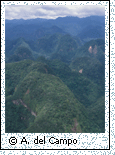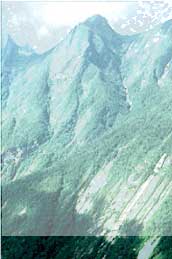
On May 22, 2001, the President of Peru, Valentín Paniagua, signed a decree establishing Parque Nacional Cordillera Azul. The Park protects a pristine area of Andean forests that is bigger than the state of Connecticut and is extraordinarily rich in biological diversity. Creation of the Park marks a major victory for conservation, but the work is just beginning to ensure effective protection of Cordillera Azul's animal and plant communities.  Ringed by sheer rock escarpments that run as far as the eye can see, Parque Nacional Cordillera Azul is a mix of mountain crests and ridges with abundant landslides as well as broad lowland valleys and slopes, high-altitude lakes and marshlands, and unusual, eroded rock formations. Ringed by sheer rock escarpments that run as far as the eye can see, Parque Nacional Cordillera Azul is a mix of mountain crests and ridges with abundant landslides as well as broad lowland valleys and slopes, high-altitude lakes and marshlands, and unusual, eroded rock formations.The dramatic landscape of the national park is home to an extraordinary diversity of plants and animals that have thrived by adapting in a variety of ways. During their three-week survey of the Park in 2000, the Rapid Biological Inventory team (comprised of Field Museum and Peruvian scientists and international collaborators) registered more than 1,800 species of plants and animals, 28 of which were new to science. The Rapid Biological Inventory team also identified imminent threats to this remote world. Although virtually no people live within Parque Nacional Cordillera Azul, coca fields, logging operations, new roads, and colonization lie just outside its borders. |
||
 |
 |
Park Story | Park Map | Tools | Image Gallery | Science in Action Home | Calumet BioBlitz Home |
||
© 2002 The Field Museum, All Rights Reserved 1400 S. Lake Shore Dr, Chicago, IL 60605-2496 312.922.9410 |
|